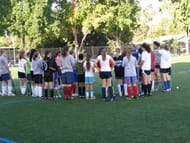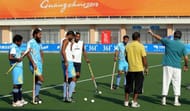Clear and effective communication plays a vital role to achieve the following coaching objectives:
• It helps translate the coach’s coaching philosophy, game plan and style of hockey to the athletes• It enables the team to play in its peak performance zone during competition• It guides both the individual athletes and the team, as a whole, to reach its full potential
There are two basic requirements for coach-athlete communication to be effective:• A healthy coach-athlete relationship, that is based upon respect, loyalty, trust and mutual understanding• Active participation of both parties in the communication, which essentially is a two-way process
Clear and effective communication does take time to develop. However, once this is achieved, the outcome is a positive environment, where teams flourish and grow, while also having fun.
TYPES OF COMMUNICATIONS:There are fundamentally two types of primary communication:• Verbal Communication: where we use words to communicate and express our views.• Non-verbal Communication: where we communicate via our body language, either consciously or unconsciouslyAccording to Jan Hargave and Associates: “Our words make up only 7% of what we communicate to others. The remaining 93% is non-verbal information. Our bodies do not lie.”
EYE CONTACT:Eye contact is an important part of non-verbal communication. To maintain eye contact with one’s student athletes, coach can request them to do three things, in the following order:• Can I have your attention please?• Please come closer, in a semi circle?• Now, I like to have your eye contact … here we go
Eye contact demonstrates that the student athletes are paying attention to the coach, listening, and trying to understand the message being conveyed. Eye contact also gives instant feedback – coach can judge whether he is being successful in conveying his message or not. And do the adjustments, accordingly. Since face is the index of the mind, one can also judge if the athlete is attentive and interested or not.It is a good practice to organize the athletes in a semi-circle in front of the coach, this way each individual athlete can have eye contact with the coach at any given time. Please also, make sure that the athletes are not facing the sun, as this will distract them. EXAMPLES OF EFFECTIVE COMMUNICATION:

In the above left photograph, please note the body language of these U-14 student athletes, who are organized in a semi-circle. It is fair to say that most of them are listening attentively to their coach. The photograph on the right is of the U – 16 student athletes, listening to their coach.
SHINING EXAMPLE:Another example of effective communication is from the 1985 Junior Men’s World Cup which was held in Vancouver, Canada. It was admirable to see how organized and disciplined the Pakistani juniors were. During the half-time of their matches, the athletes lined up in order of their playing positions, starting from the Goalkeeper, Right Back, Left Back, leading up all the way to the Left Winger. This way, the Pakistani coach Asid Malik, knew exactly where each athlete was, and gave appropriate half-time feedback and coaching tips, accordingly. The Pakistan junior national team won the bronze medal, in this tournament. AN EXAMPLE OF INEFFECTIVE COMMUNICATION:
When the student athletes are not paying attention, there is a breakdown in communication, Please see the photograph below to illustrate this point:

Photograph courtesy Press Trust of IndiaCoach Jose Brasa is giving instructions to the Indian team at a practice session during the 2010 Asian Games in Guangzhou, China. If a picture is worth a thousand words, the photograph reveals the following points about the players’ attention levels:• Extreme Left: This player is in his own world, and not listening or showing respect• Second from Left: Captain Rajpal’s body language and posture is positive and powerful• Third from Left: Sarvanjeet is in his own world of dreams.• Fourth from Left: Is defender Dhananjay Mahadik more interested in facing the camera, than listening to his coach?• Fifth from Left: Bharat Chikara is the most attentive student athlete, listening to and making eye contact with the coach
CONCLUSION:The other day, I was flipping through the pages of the book, “The power of eye contact”, by Michael Ellsberg. Its first chapter is titled – What Bill Clinton knows about Eye contact. The author gives examples of President Clinton’s communication style, with quotes. No wonder, the former U.S. president was and is such an effective communicator and one – we coaches – can learn so much from this charismatic leader.
